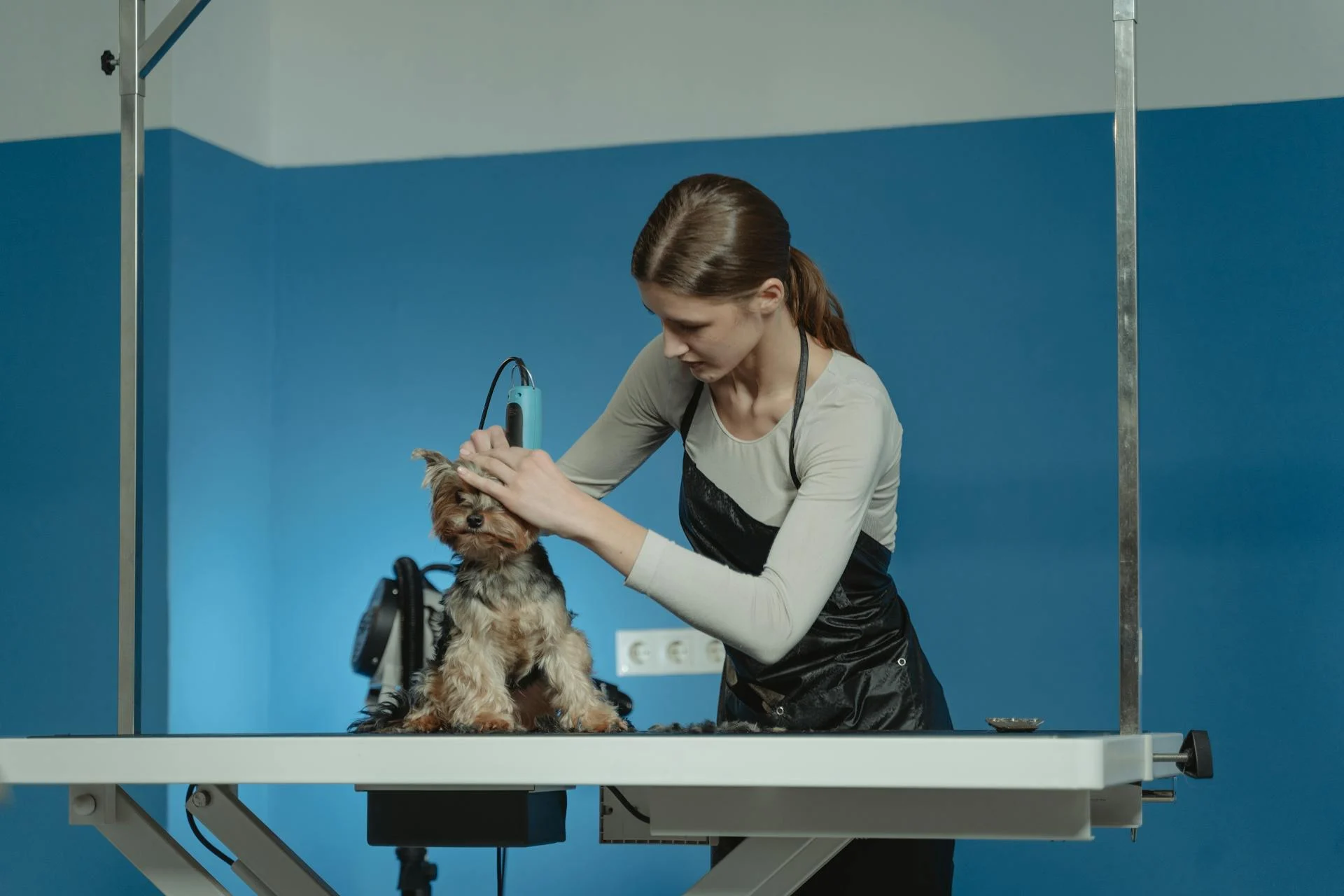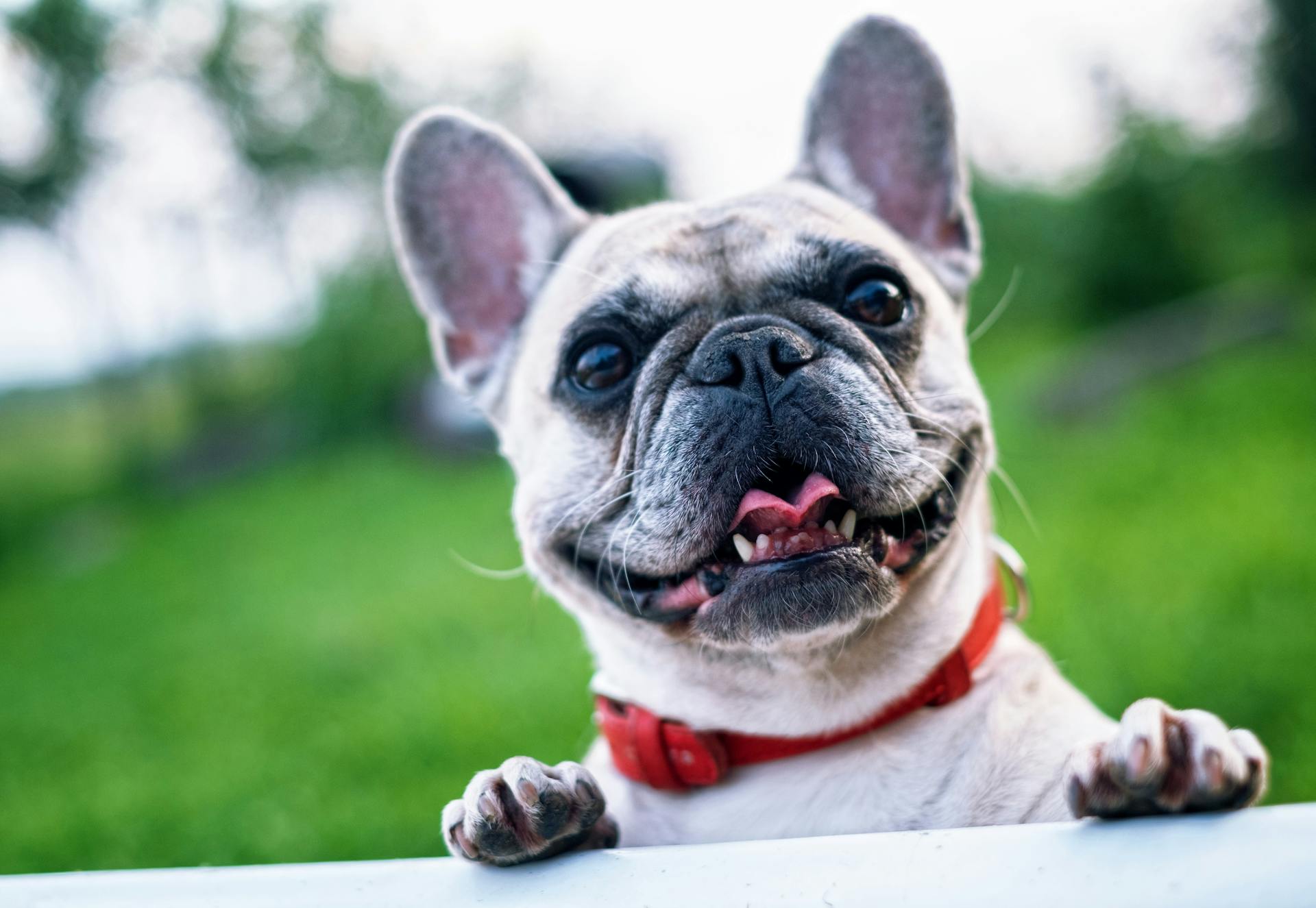
Designer dogs have become increasingly popular in recent years, with many people falling in love with their unique appearance and charm. This trend has led to a multi-billion dollar industry, with many breeders and pet stores capitalizing on the demand.
The term "designer dog" was first coined in the 1990s to describe the intentional breeding of two purebred dogs to create a new, unique hybrid. The goal was to create a dog that combined the best characteristics of both parent breeds. However, this practice has raised concerns about the welfare of the dogs involved.
Many designer breeds are created by crossing two purebred dogs of similar size and temperament, resulting in a puppy that is often priced at a premium. This can make it difficult for people to afford the dogs, leading some to wonder if the high prices are justified.
Curious to learn more? Check out: Purebred Shiba Inu
The Ethics of Designer Dogs
The ethics of designer dogs are a complex issue. Many owners of designer dogs are misled into believing their dogs are a "better" version of an established purebred breed.
Readers also liked: Designer Dog Names
In reality, designer dogs are often bred for extreme traits, such as a tiny size, which can make a dog prone to injury. The combination of two breeds can create unpredictable temperaments in puppies, and many designer dogs experience high anxiety and reactivity as a result.
Some breeders of designer dogs are purely motivated by profit, and forego important responsibilities like genetic testing and temperament assessments. In contrast, ethical breeders may spend decades carefully refining their bloodlines, and often only produce one or two litters of puppies every few years.
Designer Dog Breeds and Their Risks:
- Pomskies (Husky + Pomeranian) may experience bone and joint issues like hip dysplasia and luxating patellas.
- Labradoodles (Lab + Poodle) may have unpredictable temperaments due to the vastly different mental and physical stimulation needs of the two breeds.
- Teacup varieties are often prone to injury due to their extreme small size.
What is a Doodle?
A Doodle is a hybrid cross between any breed and the Poodle. They come in many shapes, sizes, and colors.
People adore Doodles thanks to their cute names and intriguing appearances. The term “Doodle” refers to a hybrid cross between any breed and the Poodle.
Popular Doodle mixes include combinations such as the Labrador Retriever and Poodle (Labradoodle), Golden Retriever and Poodle (Goldendoodle), and the Bernese Mountain Dog and Poodle (Bernedoodle).
You might enjoy: German Shepherd Miniature Poodle Mix
What Does It Mean to Be an Ethical Breeder?
As someone who's passionate about animal welfare, I believe being an ethical breeder is crucial in the pet industry. An ethical breeder is one who prioritizes the health and well-being of their animals above all else.
They don't breed animals for extreme traits, like the "teacup" varieties that are prone to injury. Instead, they focus on breeding dogs that are healthy, well-tempered, and free from inherited health problems.
Inbreeding, which occurs when offspring are produced from a male and female who share the same family line, can lead to a "double dose" of genetic vulnerability to certain health problems. This is why it's essential for breeders to avoid inbreeding and prioritize genetic diversity.
To be an ethical breeder, you should investigate the breeder's reputation and ensure they're breeding animals with responsible and careful practices. This means researching the breeder's history, visiting their facility, and asking plenty of questions about their breeding program.
Explore further: Dental Health Diets for Dogs
Here are some key characteristics of an ethical breeder:
- They prioritize genetic diversity and avoid inbreeding.
- They breed animals for their natural traits, rather than extreme characteristics.
- They provide a safe and healthy environment for their animals.
- They are transparent about the health and temperament of their animals.
By choosing an ethical breeder, you can help promote responsible breeding practices and ensure that you're bringing a healthy, happy animal into your home.
Breed Manipulation
Breed manipulation is a serious concern in the world of designer dogs. It's a practice that can lead to unhealthy and even life-threatening conditions for animals.
Selective breeding has been used for centuries to create desired traits in dogs. However, this selective breeding has given way to hundreds of different dog breeds, each with their own set of characteristics.
Breed standards are arbitrary characteristics desired by animal fanciers, and they don't necessarily create better dogs. In fact, animals who don't meet breed standards are no less healthy than those who do.
The pug is a prime example of how breed manipulation can harm animals. Selective breeding has resulted in an extremely flat face, which contributes to breathing difficulties and eye injuries.
Inbreeding is a form of breed manipulation that occurs when offspring are produced from a male and female who share the same family line. This can lead to a "double dose" of genetic vulnerability to certain health problems.
Some designer dog breeds, like the "teacup" varieties, are bred for extreme traits that can make them prone to injury.
Here are some ways to discourage breed manipulation:
- Educate your friends and family about the risks of breed manipulation.
- Adopt your next friend from an animal shelter or rescue.
- If you must purchase a purebred, make sure you have investigated the breeder and their reputation for careful and responsible breeding.
Health Risks of Inbreeding
Inbreeding is a major concern when it comes to designer dogs. By mating closely related dogs, breeders increase the chances of their offspring inheriting two copies of recessive genes, leading to genetic problems.
This is not just a problem for designer dogs, but also for rare breeds. The lack of genetic diversity in these breeds makes them more susceptible to health issues.
Inbreeding can create serious health complications, including increased rates of genetic disease. Unfortunately, many breeders of designer dogs are purely motivated by profit and don't take the necessary steps to ensure the health of their puppies.
Curious to learn more? Check out: Designer Dog Breeds That Are Small and Hypoallergenic
The combination of two breeds can create unpredictable temperaments in puppies, and many designer dogs experience high anxiety and reactivity as a result.
Here are some examples of breed manipulation that can harm animals:
Inbreeding occurs when offspring are produced from a male and female who share the same family line, inheriting a "double dose" of their parents' genetic vulnerability to certain health problems.
The offspring of inbred animals are likely to have poor overall health, making it essential to be cautious when considering a designer dog.
If you're considering getting a dog, remember that mixed-breed dogs are not necessarily healthier than purebred dogs. Both types of dogs can share the same common inherited disease variants.
In fact, a study examining genetic disease distribution in over 100,000 dogs found that purebred dogs show slightly higher rates of genetic diseases, but mixed-breed dogs are by no means free from these health abnormalities.
By understanding the risks of inbreeding, you can make informed decisions about your next furry friend.
A unique perspective: Mixed Breed Small Dogs for Adoption
Designer Dogs vs Purebred Dogs
Designer dogs are often touted as a healthier or better version of a purebred breed, but the truth is, they can be just as problematic. This is because designer dogs are created by breeding dogs from different breeds, which can result in unpredictable and often undesirable traits.
Many designer dog owners are misled into believing their dogs are a "better" version of an established purebred breed. This isn't their fault – it's the fault of the so-called breeders who make false promises about the health and temperament of their dogs.
In fact, purebred dogs take decades to standardize, and ethical breeders are very careful to only choose mating pairs that are compatible both physically and temperamentally. Unfortunately, this level of care and consideration is often lacking in the creation of designer dogs, which can lead to serious health complications.
You might like: Designer Dogs Breeds
Dogs vs Purebred Dogs
Designer dogs are just a few generations away from being considered purebred dogs in their own right. They're a genetic mix, which means they can express traits in a very variable way.
In fact, designer dogs often fail to "breed true" and can be very different from one another with respect to many traits. This is because they're not yet a stable breed.
As designer dogs are bred to each other and desirable traits are selected for, the genetics of that breed will become more homogenous. This is what happened with the Australian Labradoodle, which is now attempting to achieve breed status with kennel clubs around the world.
Over time, pairings of dogs with the group will breed true, producing dogs that match characteristics of the parents and the other dogs in the breed.
Worth a look: Could Shiba Inu Hit $1
Battle of the Mixes: Mutts
Mixed-breed dogs, often referred to as mutts, have a reputation for being healthier than purebred dogs. However, this isn't necessarily true.
In fact, the health of a mixed-breed dog depends on the genetic diversity of its parents. If you cross two unrelated breeds, you can actually reduce the likelihood of genetically based health problems in the offspring.
But, if you breed those puppies with each other, you're likely to increase the risk of genetic health issues. This is because you're introducing more inbreeding, which can lead to a higher incidence of inherited health problems.
One way to combat this is to create a large number of the cross-bred dogs and use many of them in subsequent breeding. This can help to reduce the risk of genetic health problems by increasing the genetic diversity of the offspring.
Ultimately, the health of a mixed-breed dog will depend on its individual genetic makeup, rather than its mixed-breed status.
Frequently Asked Questions
Does AKC recognize designer dogs?
The AKC does not recognize designer dogs as official breeds. However, the ACHC recognizes crossbreed hybrid dogs, including popular mixes like the Labradoodle.
Sources
- https://www.thewildest.com/dog-lifestyle/truth-behind-designer-dogs-and-dog-breeding
- https://www.nhes.org/breed-manipulation/
- https://medium.com/@kendle.frank/the-doodle-epidemic-why-people-have-beef-with-doodles-f5d947774eff
- https://www.petmd.com/dog/care/evr_dg_deconstructing_the_designer_dog
- https://rockykanaka.com/mixed-breed-vs-purebred-dogs-health-debate/
Featured Images: pexels.com


